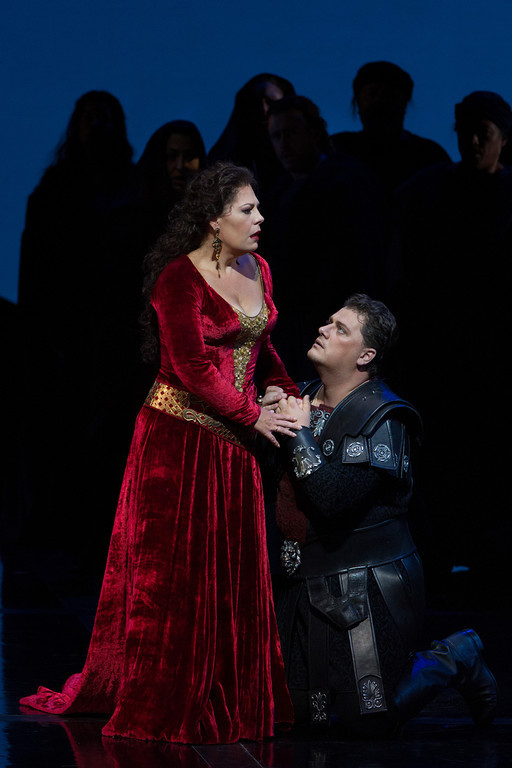Radvanovsky’s luminous vocalism elevates the Met’s static “Norma”

Sondra Radvanovsky and Aleksandrs Antonenko in the Metropolitan Opera production of Bellini’s “Norma.” Photo: Marty Sohl.
Resuscitating a production that premiered in 2001 to less than stellar reviews takes some courage, but it quickly became apparent that the main reason for the Metropolitan Opera’s revival of Vincenzo Bellini’s Norma, was as a vehicle for for the powerhouse soprano Sondra Radvanovsky. The infamously demanding title role requires a hefty dramatic edge, all the while coupled with ease and agility, and Radvanovsky could not be more perfectly tailored.
Sondra Radvanovsky is no stranger to the Metropolitan Opera, having tackled numerous roles since her debut in 1996 and is known especially for her Verdi. But here, she demonstrated her versatility. Her easy coloratura was matched by her ability to dig in to her larger dramatic voice, which was especially evident in the scene at the end of Act I in which Norma angrily turns on Adalgisa and Pollione.
By contrast, her Casta Diva aria in Act I as she sings to the goddess of the moon, was agile and unbelievably controlled. Her messa di voce singing and ability to float effortlessly at the top of her range at a pianissimo dynamic were breathtaking, and her quick scalar work nimble and always perfectly tuned.
Kate Aldrich as the younger love interest Adalgisa was less successful. When singing next to Radvanovsky, it was evident how much less nuance and strength her voice had, but her impassioned singing worked beautifully with Radvanovsky’s in the duet Mira, o Norma.
Aleksandrs Antonenko as the cheating Pollione, with his bright but staunch, rooted sound, was a terrific counterpart to Radvanovsky. His opening aria Meco all’altar di Venere, in which he sings about his newfound love, had Antonenko grabbing a high C with ease and reliability. James Morris as Oroveso, the head of the Druids, was perfectly suited to the role, Eduardo Valdes portrays Flavio, Pollione’s friend, and Siân Davies madde her Met debut as Clotilde, Norma’s confidante.
Conductor Riccardo Frizza masterfully followed Radvanovsky, allowing her the freedom that the bel canto tradition requires. The orchestra was buoyant, but tight under his baton.
John Copley’s production, 12 years later, still leaves something to be desired. The set is minimal and cold, and the costumes strange – Norma’s sequined gowns seem out of place in the Druid setting, even for a goddess, compared to the other Druids’ drab costumes. The direction by Stephen Pickover is also quite stiff and the action static. The large chorus is often seen walking in a circle or just standing and staring at the action. Perhaps this was the concept, but there could have been more thought given to movement within the staging.
Luckily, this opera’s success rests entirely on the shoulders of the soprano who plays the role, and Sondra Radvanovsky’s stunning performance rises to the occasion.
Norma runs through Nov. 1. Angela Meade sings the title role and Jamie Barton sings Adalgisa on Oct. 24 and Oct. 28. metoperafamily.org. 202-362-6000.
Posted Oct 05, 2013 at 10:07 pm by fildivoce
Ms. Vastek, you praised SR’s «messa di voce singing». «Messa di voce» [literally, «placing of the voice»] is a specific feat: beginning a sustained tone piano, then crescendo-ing it to forte, and diminuendo-ing it back to piano. I was unaware that Miss Radvanovsky had executed that during the Norma performance. Did you perhaps mean «mezza voce» [literally, «half voice» — singing at a gentle dynamic level instead of giving out all the voice]?